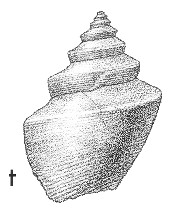
Revised descriptions of New Zealand Cenozoic Mollusca from Beu and Maxwell (1990)

 | Revised descriptions of New Zealand Cenozoic Mollusca from Beu and Maxwell (1990) | 
|
  (Pl. 27t): holotype, GS 1975, Z17/f7499, Moutara Point, coast between Whangara and Tolaga Bay, north of Gisborne, Tongaporutuan (TM6803, GNS) |
Beu & Maxwell (1990): Chapter 12; p. 251; pl. 27 t.
Synonymy: Waitara pagodula Powell 1942, p. 168
Classification: Conidae: Raphitominae
Description: Large for family (probably reaching at least 80 mm x 45 mm; dimensions of holotype of T. liratula), biconic, wide, with short pagodiform spire (probably about 0.3 total height), wide, almost smooth, gently sloping, almost flat sutural ramp, narrow smooth keel around shoulder, and wide, long last whorl tapering very gradually to straight, widely open siphonal canal. Spiral sculpture of very weak, low, wide spiral cords, about 6 below shoulder on spire whorls and many closely spaced below shoulder on last whorl, and few weak threads on outermost sutural ramp. Axial sculpture of growth lines only, defining an exceedingly deep anal sinus on sutural ramp, with widely rounded apex over inner half of ramp and long, forward-swinging limb over outer half of ramp. Aperture long, narrow, subrectangular, with thin lips. Protoconch not preserved on New Zealand fossils, but presumably raphitomine (conical, with decussate fine diagonal threads) as on the modern species, T. mirabilis Angas, 1877.
Comparison: The equally widespread Opoitian bathyal species Thatcheria liratula differs from T. pagodula in its coarser spiral cords, its more nearly horizontal sutural ramp, and its consequently much more strongly stepped spire. Specimens have been seen from Mangawhero Stream, Wairoa district, Hawke's Bay (the large incomplete holotype, 79 mm high, and Powell's illustrated paratype), Castlepoint, eastern Wairarapa (another large shell, 71 mm high) and the head of Waihua Valley, Wairoa. The unique holotype of T. waitaraensis is an incomplete large specimen of a narrow species with a more steeply sloping sutural ramp than on T. pagodula or T. liratula, and the doubtfully significant subgenus T. (Waitara) Marwick, 1931 has been retained for it at present. An unnamed Thatcheria species with early whorls prominently keeled, as on the Recent type species T. mirabilis Angas, 1877, is represented by small spires from the Stillwater Mudstone on the old Marsden-Kumara Road, Hokitika, Westland (Clifdenian) and probably other species will come to light in Neogene bathyal facies. We refer tentatively to Clinura Bellardi, 1875 the unique holotype of Waitara generosa (Altonian ?, Mangatutae Creek, Waikohu, Gisborne), which resembles Thatcheria species but has a taller spire, a much more strongly concave sutural ramp and a more strongly protruding peripheral keel than in Thatcheria. C. generosa is similar in shape to Clinura calliope (Brocchi, 1814) (type species of Clinura; Charig 1963, pl. 47, fig. 9, 10) but has much weaker spiral sculpture and lacks the prominent peripheral nodules of C. calliope.
Charig (1963) reviewed the relationships of Thatcheria, Waitara and Clinura in some detail, with a long historical introduction. He concluded these three taxa are closely related, and belong in a subfamily of Turridae closely related to the Raphitominae. He reillustrated Powell's (1942) figured paratype of T. liratula. We agree with Charig's conclusions and, although we largely follow the generic classification adopted by Fleming (1966b), it seems possible that T. (Waitara) waitaraensis and Clinura generosa will prove to belong in Thatcheria (sensu stricto) when more complete material is collected. Subsequently, Puillandre et al. (2008) showed that Thatcheria belongs in Raphitominae, based on molecular phylogeny, which is no great surprise in view of the tall, decussate raphitomine protoconch present on the type species, T. mirabilis Angas, 1877 (Recent, bathyal, N Australia to S Japan).
Distribution: Tongaporutuan; Moutara Point, coast between Whangara and Tolaga Bay, north of Gisborne (type); uncommon in bathyal siltstone in Wainuioru Valley, southern Wairarapa (Tongaporutuan) and in road cuttings on the hill south of Te Araroa, East Cape (Tongaporutuan), so probably widespread in bathyal facies.
Cite this publication as: "A.G. Beu and J.I. Raine (2009). Revised
descriptions of New Zealand Cenozoic Mollusca from Beu and Maxwell (1990). GNS
Science miscellaneous series no. 27."
© GNS Science, 2009
ISBN
978-0-478-19705-1
ISSN 1177-2441
(Included with a PDF facsimile file
copy of New Zealand Geological Survey Paleontological Bulletin 58 in CD version
from: Publications Officer, GNS Science, P.O. Box 30368 Lower Hutt, New
Zealand)